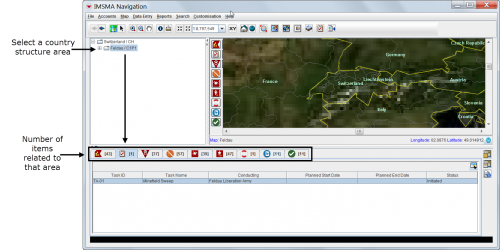The
IMSMA Navigation Window immediately displays at the launch of the system.
The IMSMA Navigation Window has three panes: the Country Structure Pane, the Map Pane and the Items Pane. The contents of the Item and the Map pane is controlled by the Country Structure pane. Users can browse the data by clicking in the Item pane or the Map pane.
The Items pane displays approved information. Each item has its own Summary Window that can be opened to browse for linked information and details. Throughout IMSMANG, functions and features display in smaller windows over the IMSMA Navigation window.
Contents
Selecting the Country Structure node of your choice

Displaying items on the map
In order to see the items on the map, you must first enable the map themes. See Enable a Map Theme. Then select items in the Item Pane, and click on the Show All or Show Selected icons.
500px
Items with a grey background in the items pane do not have geographic coordinates and they cannot be displayed on the map.
500px
Identifying an item from the map
- Click the Select icon on the navigation bar.
- Drag the cursor around the icon or icons that you want to select. The corresponding item records will be highlighted in the items panel.
500px
Viewing Additional Data on the Map
Using the map tools
500px
500px
Using the map tools activates the map status bar in the bottom of the IMSMA Navigation window.
400px
Displaying items by subcategories
500px
Displaying auxiliary data
500px
Displaying labels
500px
Browsing the Items Pane
Rearranging Displayed Columns
500px
Selecting which Columns to Show
500px
Opening an Item Summary Window
500px
Viewing Linked Items of the Selected Item
 |
Summary windows can be customised and may present different tabs and summary headings. Contact your local administrator if you cannot find the links table.
|

Viewing Associated Data Entry Forms
500px
Browsing Locations
500px
Browsing Tasks
500px
 |
Task is neither auxiliary data nor an item, thus it does not have Summary Window.
|
Viewing Auxiliary Data Lists
Choose Data entry and select an auxiliary data type.
500px
500px
500px
 |
Lists of auxiliary data provide direct access for adding new data or editing existing data.
|

